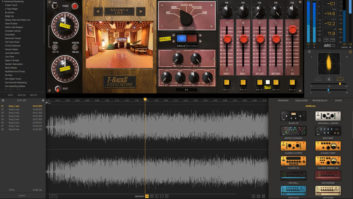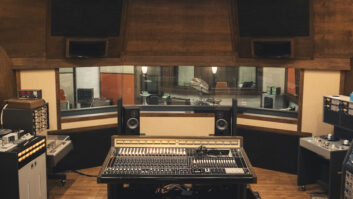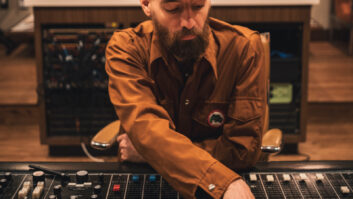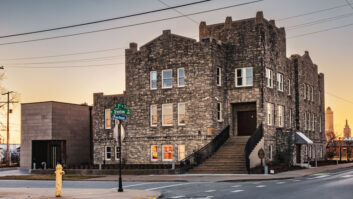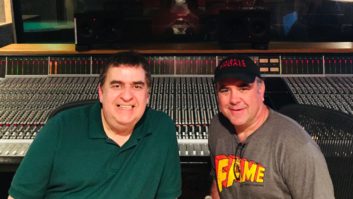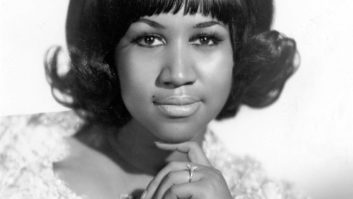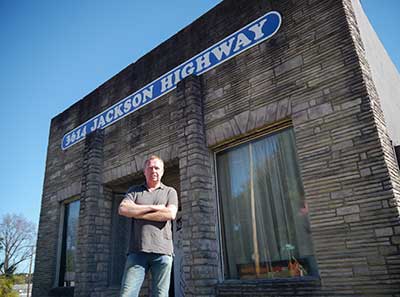
It’s all there—the booth where Mick Jagger cut vocals, the toilet where Keith Richards finished writing “Wild Horses,” the original insulation tiles that heard a generation’s worth of landmark music.
Now, Muscle Shoals Sound is coming back to life at its original location, 3614 Jackson Highway in Sheffield, Ala., thanks to a grant from Beats By Dre and the expertise of skilled acoustician Michael Cronin.
Since the documentary Muscle Shoals debuted in 2013, more than 25,000 people from 42 countries have made the pilgrimage to the studio where The Rolling Stones, Bob Dylan, Lynyrd Skynyrd and many others cut iconic recordings. The interest sparked Judy Hood, wife of “Swamper” bass player David Hood, to team up with Fame Recording Studios principal Rodney Hall to establish the Muscle Shoals Music Foundation.
The nascent group raised the first funds to purchase the 3614 Jackson Highway building and adjacent properties while the movie screened at Sundance. Beats got involved this year to help the foundation restore the historic building to its 1969-71 period and preserve it as an active studio.
“We see the recording studio as both an engine of sound production, as well as a center of community where creative people come together to make music,” says Beats President Luke Wood. “It is important that Muscle Shoals continues to be a vibrant, living studio that can help shape the next generation of players, producers and engineers.”
The Muscle Shoals Foundation plans to continue its tours—led by head “Swampette” Hood—and open the studio to musicians during off hours, similar to the model Sun Studios in Memphis uses to stay open. In fact, Jerry Phillips, son of Sun Studios founder Sam Phillips, serves on the foundation’s board.
“Clearly it has to be open because of the music heritage,” Hood says, “but we also have the analog recording equipment. We feel like we have a moral obligation to keep it open. This is a pilgrimage for a lot of people.”
Beats brought in Cronin, the veteran studio designer whose credits include Blackbird in Nashville and many more studios around the world, to study and re-create the acoustical environment of the original studio.

“Barry Beckett [original Swamper] used to tell me about this place, about Aretha Franklin, and I never thought I’d be standing here,” marveled Cronin. “I had just watched the Muscle Shoals documentary, and a week later I got a call from Beats.”
Cronin’s strategy relied on documenting the entire building, inch by inch, including the size and shape of the room and isolation booths, as well as the materials used in the studio—some of which were still attached to the walls nearly 50 years later.
“The original acoustic material was ceiling tiles and burlap with insulation behind it, which was typical of the time period,” Cronin says. “Fame Recording was the same, like Sun Studios and RCA Studio B in Nashville. They added it until it sounded good and then stopped there.”
If anything, Cronin is sweating the details. According to Hood, the place was “crawling with architects” gathering every detail of the space before reconstruction began. Even the original air duct and electrical outlets and conduit will remain in the building, although the crew will pull new wiring and install a modern central air and heating system.
The main recording room takes up most of 3614’s street level, with add-ons like the vocal booth, drum isolation booth, control room and a closet-size bathroom jutting into the space. The versatility of the room’s appendages is apparent today, even as the studio is undergoing renovations. Standing in the vocal booth and turning toward and away from the tiles, Cronin shows how the space was used. “You’ve got more of a live end and a dead end, so if you’re recording this way or that way, acoustically, sonically, it’s a different sound.”

New soundproofing challenges that didn’t exist when the building was originally an operating studio also came into play. For example, the formerly sleepy Jackson Highway is now a busy, four-lane thoroughfare with traffic night and day.
The team is mediating the noise issue caused by passing vehicles by adding insulation walls to the front two rooms of the building, which served as the reception area and guitarist Jimmy Johnson’s office in the old days.
“Thirty years ago there was a highway, but it wasn’t like this—it wasn’t a racetrack,” Cronin says. “We’re isolating the perimeter to a point where it doesn’t affect the interior acoustics of the room. We’re isolating from the outside, all through here, but the interior of the room is original.”
The building, which closed in 1978 when Muscle Shoals Sound moved across town, has lived many lives since its heyday. Most notably, it was a casket shop that served the reluctant customers of Oakwood Cemetery across the street. Through all its uses, though, the original layout survived without major modifications.

“It’s amazing that for years, with all the other uses, none of this stuff got ripped out,” Cronin says. “The paneling, everything was on the walls the way it was.”
That goes for the angled glass on the control room, as well as the drum and vocal isolation booths, which somehow survived 35 years of mixed use without being ripped out and replaced with something more functional for the tenants. Even the ceiling bow created by sagging roof beams is exactly the same, although as part of the renovation the roof was raised and properly supported to restore structural integrity.
“We’ve added this LVL system of structural members to take all of the weight,” Cronin says. “The original beams aren’t bearing the weight, but the room will have the same shape.”
Walking over to the drum booth, Cronin says, “This would have been like any booth from the Westlake era. It was a semi-enclosed area. There wouldn’t have been any glass back in the ’69-’71 era. Later, when techniques changed, they added glass to get more separation.
“It was completely different then,” he continues. “It was one room. If you were doing this today, you’d be isolating everything from each other. Those things weren’t important back then.”
Acquiring period gear, including pieces that were actually in the studio, has been part treasure hunt and part pure luck for Cronin and the foundation. Once word of the project began traveling through the industry, Cronin’s phone started ringing.
“We had just had a board meeting and picked the time period to focus on re-creating,” Cronin says, “and then just by serendipity, Danny White, who had Sixteen Ton Studios, said he had this API that was ordered in 1969 and installed in 1971 in RCA Studios in Nashville, which later went into Chet Atkins’ personal studio. It was perfect for what we wanted.”
Producer Dave Cobb (Jason Isbell, Chris Stapleton), who had owned the console before White, was also a key ally in the gear hunt. He still owned the original Altec Voice of the Theater speakers that were used for playback in 3614’s main room.
“Dave just said, ‘Hey man, come get them.’ He was excited that they were going to come back to this room,” Cronin says.
The team also found one of the studio’s 8-track tape machines that had never even left the area code. When the local studios bought new equipment, often other nearby studios bought the old gear. The studio’s one-inch Scully deck was found just across the Tennessee River in Lexington, Ala.
Downstairs in the basement were offices for the musicians and where the publishing company was run, plus a secret lounge behind a false wall where they kept a keg in formerly dry Colbert County. At the rear of the basement are two echo chambers where the Swampers created reverb and delay with a microphone and a raw speaker, relying on physical distance to calculate the time.
For the foundation, acquiring the building felt like a coup—but that quickly faded as the financial reality of renovating the space set in. Luckily, Beats arrived on the scene at the right time.
“We thought we had to spend the next 10 years raising money to do something with it,” Hall says. “Then we got a call from Rafferty Jackson who was with Beats, and she said, ‘I think I can help you with your studio project.’ And they did.”
Muscle Shoals Sound is scheduled to fully reopen in March 2016.
